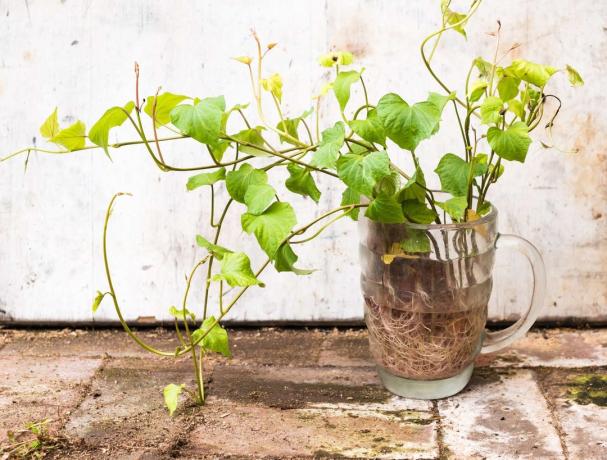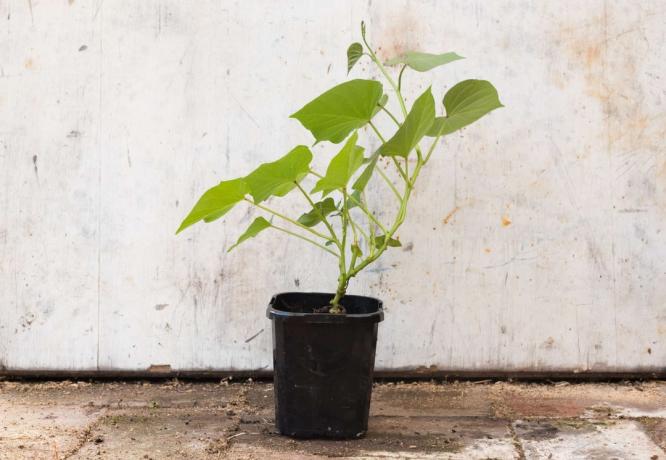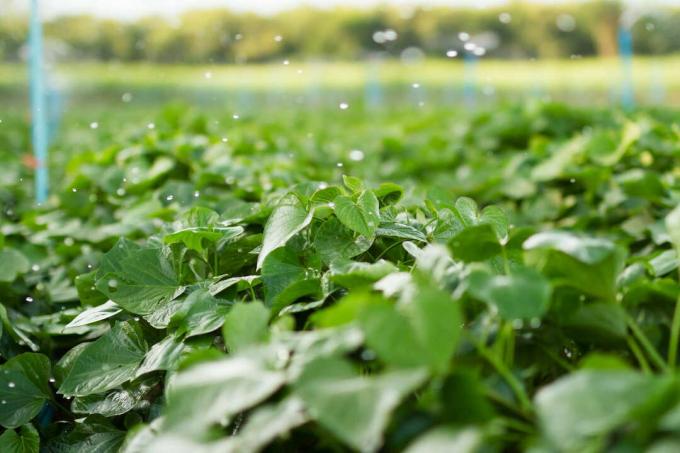It is the trend vegetable par excellence: the sweet potato. We will show you the tips and tricks for growing sweet potatoes in your own garden.

A few years ago it was sweet potato (Ipomoea batatas) still an unknown exotic species, today you can find the delicious tuber in almost every restaurant. Whether fried, steamed, mashed or grilled - the sweet potato is extremely versatile and at the same time very healthy. So it's no wonder that more and more hobby gardeners have taken a liking to the tasty crop and want to grow it in their garden. Fortunately, the tuber from Central America also feels at home in our latitudes and is excellent for cultivating in the garden. What ten tips and tricks you can use when cultivation of the sweet potato we will tell you in our special article.
contents
- 1. Sweet potato tip: the right variety
- 2. Sweet potato tip: the right location
- 3. Sweet potato tip: Let the tubers germinate
- 4. Sweet potato tip: plant sweet potatoes in the bed
- 5. Sweet potato tip: growing in a pot
- 6. Sweet potato tip: mulch or mixed culture
- 7. Sweet Potato Tip: Water
- 8. Sweet potato tip: fertilize
- 9. Sweet Potato Tip: The Harvest
- 10. Sweet potato tip: Curing
1. Sweet potato tip: the right variety
Not all sweet potatoes are the same – to be precise, the sweet potato offers an impressive range of different plants with around 7,000 varieties. The varieties differ, for example, in their skin color, which can be red, yellow or white, but the color of the flesh also ranges from white to orange to purple. There are also varieties that were bred primarily for decorative purposes and are therefore characterized by colorful leaves and particularly beautiful flowers. In addition to the visual differences, the duration of cultivation is one of the most important properties to consider when choosing a variety. In principle, only varieties that are characterized by a particularly short cultivation period should be cultivated, because only these guarantee a harvest in our latitudes. The varieties "Bonita", "Evangelina" and "Beauregard", among others, have already proven themselves in Germany and are all characterized by a short cultivation period and reliable yields.

2. Sweet potato tip: the right location
The right location is one of the decisive factors when growing sweet potatoes. In order for the tubers to develop well, loose, sandy soil is a must - the soil, on the other hand, contains a lot Obstacles such as stones or is very solid overall, deformations form on the tasty nodules and they fall smaller the end. In addition, waterlogging is more likely to occur in dense soil, which the plant does not tolerate well. As a heavy feeder, the sweet potato also likes soil that is rich in nutrients and humus (in this case it does not have to be fertilized as often). At the same time, it loves warmth and is sensitive to cold, which is why a sheltered location in full sun is ideal. If you cannot offer a sheltered location in the bed, you can also grow them in the greenhouse - Protected from harmful weather influences, sweet potatoes can be grown here even in colder regions thrive.
3. Sweet potato tip: Let the tubers germinate
Unlike, for example, the potato (Solanum tuberosum) the sweet potato is very difficult to propagate from seeds, as these do not germinate well. On the other hand, it works better to let seed tubers or tubers from the last harvest pre-germinate in the house and later plant them in the ground. To germinate, it is best to put the sweet potato halfway into the water and on a bright window sill. To prevent the plants from slipping too deep into the glass of water, it has proven useful to poke a toothpick into the sweet potato at a suitable height (similar to the Sprouting an avocado seed) to keep the tuber in place. Once sufficiently long shoots of around 20 to 30 cm have formed, the tuber is ready to make its way into the bed.

4. Sweet potato tip: plant sweet potatoes in the bed
Since the sweet potato is absolutely sensitive to cold, it should only be planted outdoors after the ice saints, when no more frosts are to be expected. If the temperatures are still in the single digits after the ice saints at night, it may be worth delaying the move a little longer. Otherwise, the cold shock could stall the growth of the plants over a longer period of time. When planting, you can either plant the entire tuber or just the individual sprout cuttings that formed during pre-germination. If the whole tuber is used, you should make sure that about half of it looks out of the ground. Similar to potatoes, growing sweet potatoes in 60 cm wide and about 20 cm high ridges is worthwhile. By growing in the dam, the soil around the sweet potato warms up faster, which promises higher growth. At the same time, excess water can drain off faster and the risk of waterlogging is reduced.

5. Sweet potato tip: growing in a pot
Of course, sweet potatoes can also be grown in pots - especially in colder regions, this method is a good alternative to growing in beds, since the Young plants can still grow in a sheltered house or conservatory and only move outdoors when the danger of cold snaps has been completely banned is. When growing in a pot, however, you should definitely make sure that the pot has a volume of at least 20 liters so that the tubers have enough space to grow. In addition, choosing a black pot can be an advantage, as it does not reflect the sunlight and the soil in the pot heats up faster. Likewise, with a sweet potato as a potted plant, the same site requirements must be observed as outdoors: The The substrate should be loose and permeable, and the sweet potato also appreciates a lot of sun and a sheltered spot Location.

6. Sweet potato tip: mulch or mixed culture
Sweet potatoes grow very slowly, especially in the beginning. The result: the bed offers a lot of bare soil for a long time, which can lead to increased soil erosion. To avoid this, the gardener has two methods at his disposal. On the one hand, you can cover the entire bed with black foil so that only the sweet potatoes peek out. In addition to protecting the soil, this method has the advantage that the soil around the sweet potatoes warms up faster, which increases growth. Another advantage is that possible weeds are suppressed by depriving them of the necessary light. Of course, organic materials such as straw or leaves are also suitable for mulching the sweet potatoes. On the other hand, the sweet potato can also be cultivated as a mixed culture: lettuce, radish (Raphanus sativus var. sativus) or spinach (Spinacia oleracea) are particularly suitable because of their short cultivation time and are harvested before the sweet potato needs all the space in the bed.

7. Sweet Potato Tip: Water
Basically, the following applies to sweet potatoes: the more leaves have developed, the more water the plant needs. While the young plants hardly need to be watered, the large plants have a very high water consumption in summer. At high temperatures and without rain, you should even provide the plants with sufficient liquid every day. Although sweet potatoes can usually survive periods of drought, the growth of their tubers suffers as a result. However, too much water also damages the sweet potato, after all, it can be very sensitive to waterlogging. Also note that ridge or pot grown sweet potatoes require more water - the ridges and pots evaporate the water much more quickly.

8. Sweet potato tip: fertilize
Because sweet potatoes are a heavy feeder, many think they need a large amount of fertilizer. In reality, the sweet potato does not have to be additionally fertilized over the entire cultivation period if you prepare the bed well at the beginning. To ensure that the sweet potato is optimally supplied with nutrients, you should use around 3 l of mature compost and 100 g of horn meal per m2 incorporate thoroughly - this saves you the hassle of fertilizer work later on. When growing in a tub, a single fertilization is unfortunately not enough. Instead, you should give some liquid fertilizer about once a week from the leaf growth phase.
9. Sweet Potato Tip: The Harvest
The sweet potato only begins to form tubers in September - so it is a real late bloomer. Therefore, their tubers are usually ready for harvest at the end of autumn, i.e. in October. Luckily, the perfect time to harvest sweet potatoes is easy to determine: as soon as their leaves turn yellow, the tubers in the ground are ripe. Sometimes, however, the weather throws a spanner in the works and the first night frosts appear even before the leaves change color. Now it's time to act quickly, because the sweet potato doesn't tolerate the cold. But don't worry: Even with an early harvest, the tubers are usually very tasty. So that you can enjoy your sweet potatoes for a long time, you should also make sure that the thin ones bark is not damaged during harvesting, otherwise the risk of rotting during storage increases.

10. Sweet potato tip: Curing
Don't worry: "Curing" is neither a new trend sport nor a complicated sweet potato dish. In fact, the name "curing" refers to the after-treatment of the sweet potato from your own garden - this is in As a rule, it is significantly less sweet than you are used to from the supermarket, as it has more starch and less sugar contains. So that the sweet potato still lives up to its name and is also easier to store, you can easily grow it at home post-treatment: To do this, simply wrap the tubers in black foil and place them in the blazing sun during the day and in the warmest at night Space. Due to the warm, humid climate inside the foil, the small wounds in the skin close and the starch inside the tuber is converted into sugar. The result: After about five days, the sweet potato is significantly sweeter and can also be stored better.



